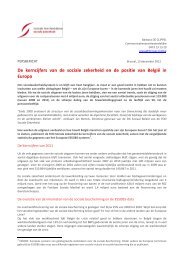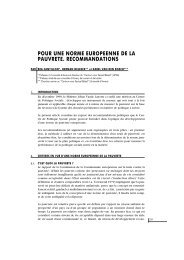Sustainability and adequacy of pensions in EU countries. A cross ...
Sustainability and adequacy of pensions in EU countries. A cross ...
Sustainability and adequacy of pensions in EU countries. A cross ...
Create successful ePaper yourself
Turn your PDF publications into a flip-book with our unique Google optimized e-Paper software.
3. To analyse the changes expected <strong>in</strong> the average first pension as a proportion <strong>of</strong> the<br />
average wage, by us<strong>in</strong>g the case <strong>of</strong> stylised male workers on average wage throughout<br />
their work<strong>in</strong>g careers <strong>and</strong> by cover<strong>in</strong>g all m<strong>and</strong>atory <strong>and</strong> important pension schemes.<br />
This <strong>in</strong>dicator, so-called theoretical replacement rate (TRR), is calculated first for those<br />
retir<strong>in</strong>g <strong>in</strong> 2006 hav<strong>in</strong>g accumulated pension rights under the current pension policies.<br />
Then, the base TRR is compared with the prospective TRR <strong>of</strong> those retir<strong>in</strong>g <strong>in</strong> 2046<br />
accumulat<strong>in</strong>g rights under the new reformed pension system, so as to measure how<br />
pension reforms will affect future pension entitlements.<br />
These three streams <strong>of</strong> analysis provide <strong>in</strong>sights <strong>in</strong>to how pension <strong>in</strong>comes for future retirees<br />
are likely to be affected, <strong>and</strong> the next three sections <strong>of</strong> this paper address them one by one.<br />
2. Pension reforms <strong>and</strong> their aggregate impact: Evolution <strong>of</strong> the Benefit Ratio<br />
Changes <strong>in</strong> Benefit Ratios over time chart the likely development <strong>of</strong> the relative value <strong>of</strong> the<br />
average pension (total public pension spend<strong>in</strong>g divided by number <strong>of</strong> pensioners) relative to<br />
the likely evolution <strong>of</strong> the average wage (approximated by the GDP per hours worked). All<br />
other th<strong>in</strong>gs constant, a decl<strong>in</strong>e <strong>in</strong> the benefit ratio over time po<strong>in</strong>ts to a fall <strong>in</strong> the generosity<br />
<strong>of</strong> public <strong>pensions</strong>, relative to wages.<br />
The projected reduction <strong>in</strong> the Benefit Ratio can also be a sign <strong>of</strong> improv<strong>in</strong>g public f<strong>in</strong>ances.<br />
However, it can also lead to greater expenses <strong>in</strong> the form <strong>of</strong> social assistance from the<br />
government if the fall<strong>in</strong>g benefit ratio resulted <strong>in</strong> an <strong>in</strong>crease <strong>in</strong> the poverty among older<br />
people <strong>in</strong> the future. Moreover, falls <strong>in</strong> the Benefit Ratio may occur because the pension<br />
system has moved partly towards private schemes, <strong>and</strong> thus revenues <strong>and</strong> expenditures from<br />
public pension schemes will be lower <strong>in</strong> the future. Such observations should be kept <strong>in</strong> m<strong>in</strong>d<br />
when <strong>in</strong>terpret<strong>in</strong>g results for the changes <strong>in</strong> the Benefit Ratio presented below.<br />
Figure 5: Changes <strong>in</strong> the Benefit ratio % (average public <strong>pensions</strong>/average economy-wide<br />
wage) a<strong>cross</strong> <strong>EU</strong>27, for the period 2007-2046<br />
9

















